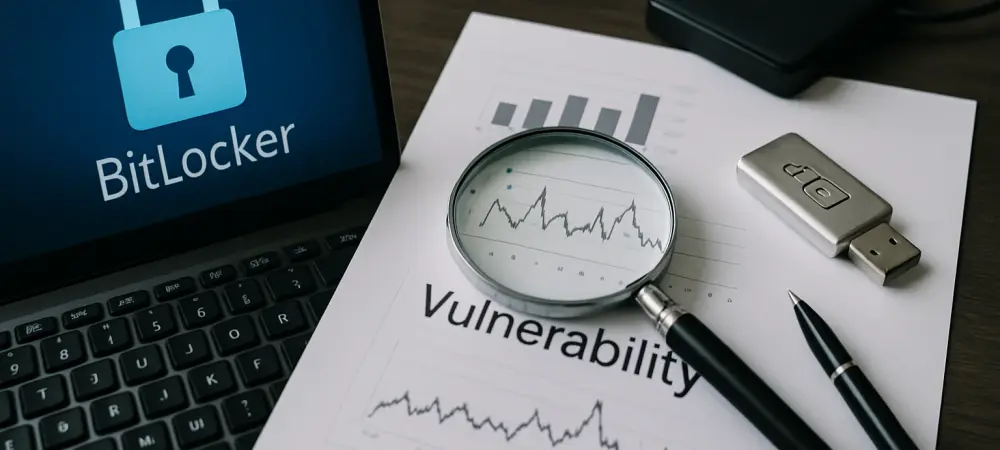In a digital age where data security is a top concern, recent revelations about a vulnerability (CVE-2025-48818) in Windows BitLocker have raised alarm bells among security experts. This defect, which hinges on a time-of-check time-of-use (TOCTOU) race condition attack, targets Microsoft’s famed encryption solution. The issue is particularly pressing as it allows attackers to bypass BitLocker’s encryption without user interaction, posing a threat to both corporate and personal data if physical access to devices is obtained.
Understanding BitLocker and Its Role in Digital Security
BitLocker, Microsoft’s stalwart defense against unauthorized access, provides full-disk encryption to keep data at rest secure. With its integration in Windows operating systems, BitLocker is designed to protect sensitive information, yet the vulnerability has exposed a potential Achilles’ heel. While BitLocker aims to uphold data confidentiality and integrity, the CVE-2025-48818 exploit highlights risks previously unnoticed, especially as it operates without the need for remote access. Microsoft’s security updates serve as a critical line of defense, as urgent patch management becomes imperative for organizations and individuals alike. Recognizing the essential role of BitLocker in safeguarding data, security experts stress the importance of rapid deployment of patches and continuous evaluation of physical security protocols to mitigate risks.
In-Depth Analysis of the Vulnerability
The CVE-2025-48818 vulnerability underscores significant stakes for Windows systems, particularly affecting Windows 10, 11, and Server editions. With a CVSS score of 6.8, its potential to compromise system security is notable. The flaw arises from a gap between security verification and resource utilization, an area ripe for exploitation should an attacker gain physical access to a device.
Insights from security experts and Microsoft’s own research have illuminated the profound implications. Some industry observers argue that this vulnerability exemplifies the need for dual-layer security, combining software and physical deterrents, to effectively combat such threats. The general consensus underscores that ignoring physical access threats could lead to severe breaches, making swift action critical.
Implementing BitLocker: A Practice Perspective
Organizations are responding with urgency to the BitLocker flaw by fortifying both digital and physical security measures. For companies safeguarding corporate and personal data, BitLocker’s encryption serves as the first line of defense, but it’s not infallible. Business leaders emphasize regular updates and audits to ensure encryption remains robust, advocating a proactive stance in preserving data integrity.
Case studies reveal varied organizational approaches to adapt—some incorporate additional layers of authentication, while others enhance staff training to recognize potential intrusion signs. Navigating encryption challenges in enterprise environments requires innovation and adaptability, fostering environments that prioritize resilience against evolving threats.
Exploring Advanced Security Innovations
Looking beyond traditional encryption, emerging security trends offer new avenues for data protection. Innovations such as AI-driven threat detection and behavior-based analytics are gaining traction, particularly as they enhance the ability to preemptively identify and neutralize potential vulnerabilities.
Regional perspectives highlight differences in cybersecurity regulations and leadership, with some areas spearheading stringent policies while others lag behind. Understanding these nuances is crucial for global entities striving to bolster their defenses cohesively. Additionally, dispelling myths about data encryption, such as its supposed invincibility, aids in fostering a realistic approach to cybersecurity strategies.
Revolutionizing Threat Mitigation Protocols
Security protocols are undergoing a quiet revolution as new approaches to threat mitigation surface. By comparing defenses across different industries, it becomes apparent that while some sectors, like finance and healthcare, have advanced cybersecurity frameworks, others may not be as robust. This comparative analysis reveals the varying degrees of preparedness and the lessons that can be shared.
Speculative futures involving AI and machine learning in cybersecurity are on the horizon, promising to reshape threat identification and response strategies. Industry leaders recognize the potential for AI-driven analytics to transform data protection realms, projecting a future where machine learning augments human decision-making in security measures.
Summarizing Key Learnings
The BitLocker vulnerability analysis distills several key learnings, underlining the urgency of addressing both system security and physical access control. Proactive measures, including continuous patch management and physical security enhancements, emerge as paramount. Tactical guidance emphasizes the necessity for organizations to safeguard encryption integrity while ensuring data safety through a multifaceted approach.
Concluding Insights on Data Protection Challenges
In reflecting upon the discussed insights, the enduring challenge of data protection became evident. Projecting future trends, organizations recognized the roads ahead for cybersecurity would require constant evolution and innovation. While defensive techniques were deployed at present, as data protection landscapes evolved, a reinforced emphasis on comprehensive digital fortresses was expected to remain critical in thwarting emerging threats.

